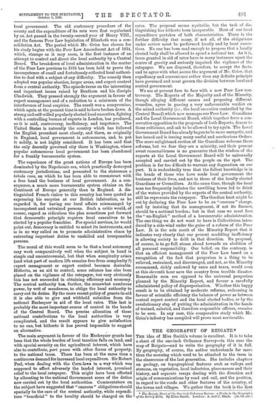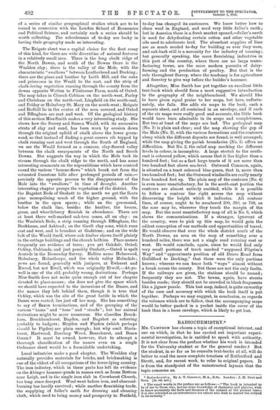THE GEOGRAPHY OF REIGATE.*
THE idea of Miss Smith's volume is excellent. It is to take a sheet of the one-inch Ordnance Survey—in this case the map of Reigate—and to write the geography of it in full. By geography, of course, the author understands far more than the meaning which used to be attached to the term in the classrooms of the last generation. She includes chapters on geology, on topographical features such as valleys and streams, on vegetation, local industries, place-names and their history, and separate essays dealing with the direction and origin of communications by road and rail, and the position, in regard to the roads and other features of the country, of the towns and villages. We gather that the book is the first • The Reigate Sheet of the One-inch Ordnance Survey : a Study in the Geogralay of the Surrey ligis. By Ellen Smith. London : A. and C. Black. [3a. 6d. net.
of a series of similar geographical studies which are to be issued in connexion with the London School of Economics and Political Science, and certainly such a series should be worth collecting. The schoolrooms of to-day are lucky in having their geography made so interesting.
The Reigate sheet was a capital choice for the first essay of this kind, for there are wide diversities of natural features in a relatively small area. There is the long chalk ridge of the North Downs, and south of the Downs there is the Wealden clay ; there is the valley of the Mole, with the characteristic " swallows " between Leatherhead and Dorking ; there are the pines and heather by Leith Hill, and the oaks and primroses in the Weald to the east, and the strip of chalk-loving vegetation running through the county from the downs opposite Wotton to Flinthouse Farm, north of Oxted. The map takes in Church Cobham on the north-west, Farley and Chelsham on the north-east, Lingfield on the south-east, and Felday or Holmbury St. Mary on the south-west ; Reigate and Redhill lie in the centre of the area covered, and Oxted and Effingham are east and west. Of the geological history of this section Miss Smith makes a very interesting study. She shows how the Surrey and Sussex Weald, with its successive strata of clay and sand, has been worn by erosion down through the original upfold of chalk above the lower green- sand, so that instead of finding a great convex rib topped by chalk running east and west through the South of England, we see the Weald formed as a concave, clay-floored valley between the chalk escarpments of the North and South Downs. She suggests the way in which the Mole took its stream through the chalk ridge to the north, and has some interesting comments on the superstitions which have centred round the various "bourne-flows" which break out from the saturated limestone hills after prolonged periods of rain,— precisely the opposite process to the disappearance of the Mole into the " swallows " in time of drought. Another interesting chapter groups the vegetation of the district. On the Bagshot Beds of Oxshott to the north we get the Scots pine monopolising much of the higher ground, with the heather in the open spaces ; while on the greensand, below the chalk line, besides the heather, the broom, gorse, and whortleberry flourish in abundance. There are at least three well-marked oak-tree zones, all on clay on the Woolwich Beds, a strip running through Effingham, the Bookhams, and Ashtead; on the Gault clay zone, which runs east and west, and is broadest at Godstone ; and on the wide belt of the Weald itself, where oak timber shows itself plainly in the cottage buildings and the church belfries. Place-names frequently are evidence of trees ; you get Oakdale, Oxted, Ockley, Oaklands, and just possibly Oxshott, Oxted is spelt Acstede in the Domesday Survey. Hollies name Holmwood, Holmbury, Holmthorpe, and the whole valley Holmdale ; yews are found, generally with junipers, at Ewhurst and Ewood, but not Ewell, which was originally Etwell,—At-ye- well is one of the old, probably wrong, derivations. Perhaps Miss Smith does not make quite enough out of her chapter devoted to place-names ; she does not give the space which we should have expected to the incursions of the Danes, and the names they left behind them, though it is true that Ockley, which was the site of the great battle in which the Danes were routed, lies just off her map. She has something to say of Saxon terminations, and of the grouping of the various " hams " and " tons " and " steads"; but her animal derivations might be more numerous. She classifies Brock- ham, Brockhamhurst, Bagden, and Bagshot as referring probably to badgers ; Hogden and Pigdon (which perhaps should be Pigden) are plain enough ; but why omit Harts- burst, Hartwood, Deerleap Wood, Bearehurst, and Beare Green P It must be owned, however, that to attempt a thorough classification of the names even on a single Ordnance sheet would be a formidable undertaking.
Local industries make a good chapter. The Wealden clay naturally provides materials for bricks, and brickmaking is one of the oldest of all occupations of the lower-lying country. The iron industry, which in these parts has left its evidence on the Abinger hammer-ponds in names such as Irons Bottom near Leigh, and in the single iron slab in Crowhurst Church, has long since decayed. Wool went before iron, and charcoal- burning has hardly survived ; while another flourishing trade, the supplying of fuller's earth for dressing and cleaning cloth, which used to bring money and prosperity to Nutfield, to-day has changed its customers. We know better how to clean wool in England, and need very little fuller's earth ; but in America there is a fresh market opened,—fuller's earth is used for dehydrating certain cotton and other vegetable oils used to adulterate lard. The abundant supplies of lime are as much needed to-day for building as ever they were, and oak-hark still is a necessity for the industry of tanning ; but generally speaking, the more flourishing industries in this part of the country, where there are no large manu- facturing towns, are the more modern pursuits of dairy- farming and the production of poultry. But that is the rule throughout Surrey, where the tendency is for agriculture and forestry to give way before the builder's hammer.
Altogether, Miss Smith has put together an excellent little text-book which should form a most suggestive introduction to the geography of the neighbourhood. We should like to have given equal praise to her maps, but here, unfortu- nately, she fails. She adds six maps to the book, each a separate sheet, and all contained in an envelope, and if each of the six maps were really good and accurate, the little book would have been admirable in its scope and completeness. But two at least of the maps are bad. The geological map (No. 1) is plain and clear; and the map showing the gap of the Mole (No. 3), with the various formations and the contours along which the different deposits are found, is well arranged; while the map giving the parish boundaries (No. 5) offers no difficulties. But No. 2, the relief map marking the different levels in colour, is incomplete. A large stretch to the south- east is coloured yellow, which means that it lies higher than a. hundred feet ; but as a fact large tracts of it are more than two hundred feet above sea-level. Outwood Common, again, is situated on a tract coloured blue-green, that is, more than two hundred feet ; but the Outwood windmills are really nearly four hundred feet up. The plain map of the contours (No. 4) is even more unsatisfactory, for in the south-east portion the contours are almost entirely omitted, while it is possible to follow a contour line right across the map without discovering the height which it indicates. All contour lines, of course, ought to be numbered 200, 300, or 700, as the case may be, wherever they touch the margin of the map. But the most unsatisfactory map of all is No. 6, which shows the communications. If a stranger, ignorant of the country, were to pick up this map, be would gain the oddest conception of our methods and opportunities of travel. He would observe that over the whole district south of the North Downs, an area on the map of something over a hundred miles, there was not a single road running east or west. He would conclude, again, since he would find only very small portions of track marked " supposed Pilgrim's Way and " approximate position of old Drove Road from Guildford to Dorking," that these were the only portions known ; whereas we can trace both " ways " almost without a break across the county. But those are not the only faults. If the railways are given, the stations should he named ; frequently they are not. The towns, again, have streets besides roads ; they should not be crowded in black fragments like a jigsaw puzzle. This last map, indeed, is quite unworthy of the care and accuracy with which the book itself is put together. Perhaps we may suggest, in conclusion, as regards the volumes which are to follow, that the accompanying maps would be better packed in a pocket inside the cover of the book than in a loose envelope, which is likely to get lost.



























































 Previous page
Previous page